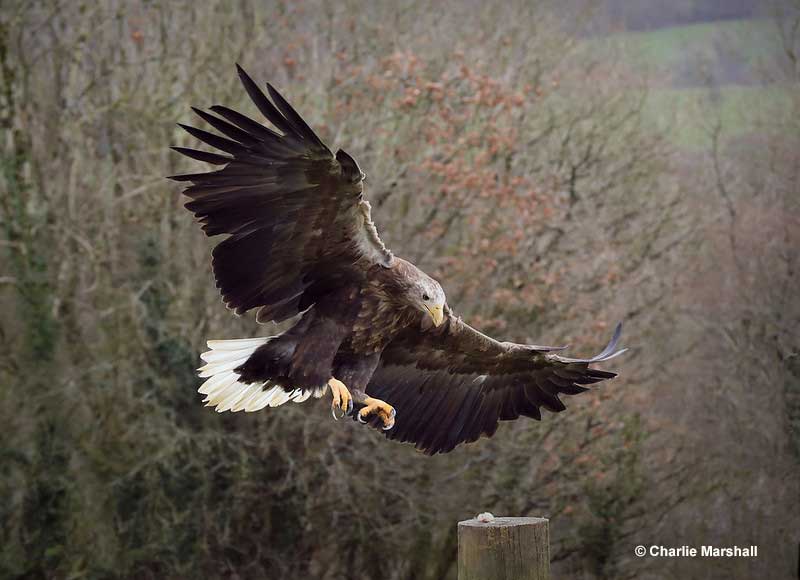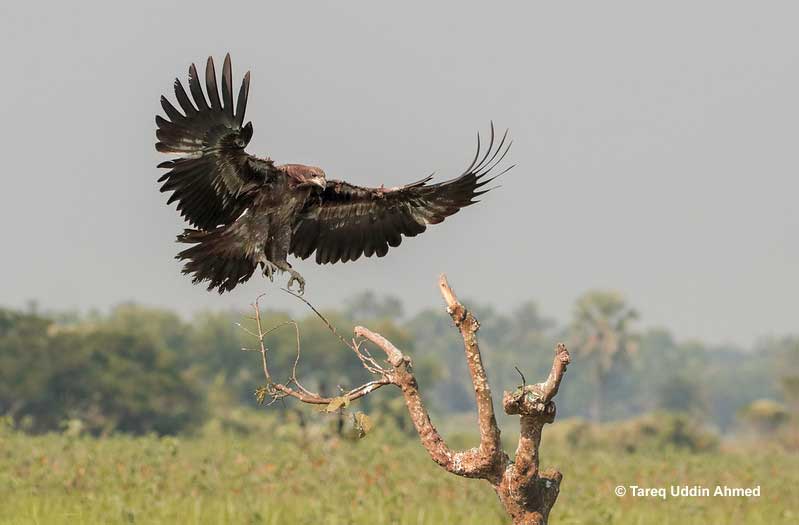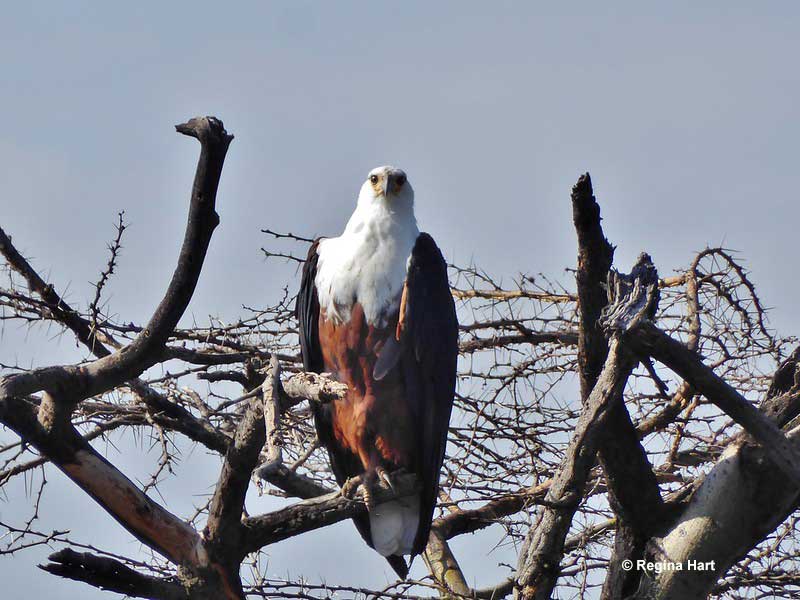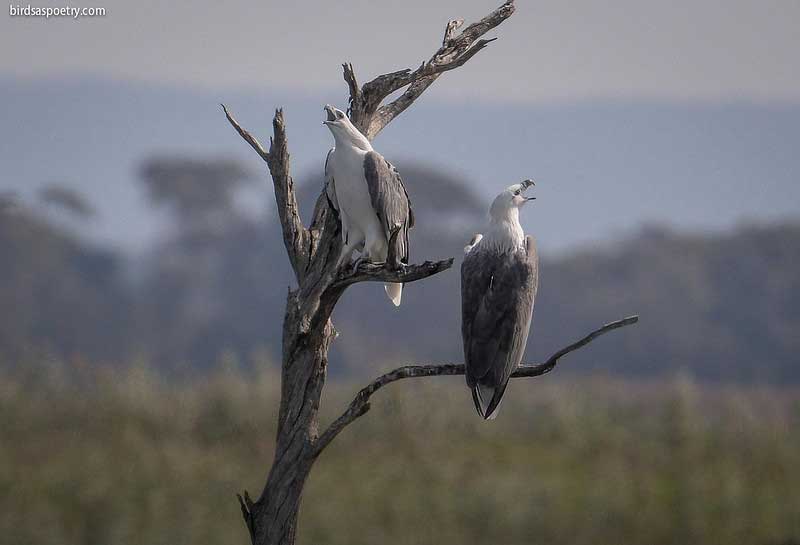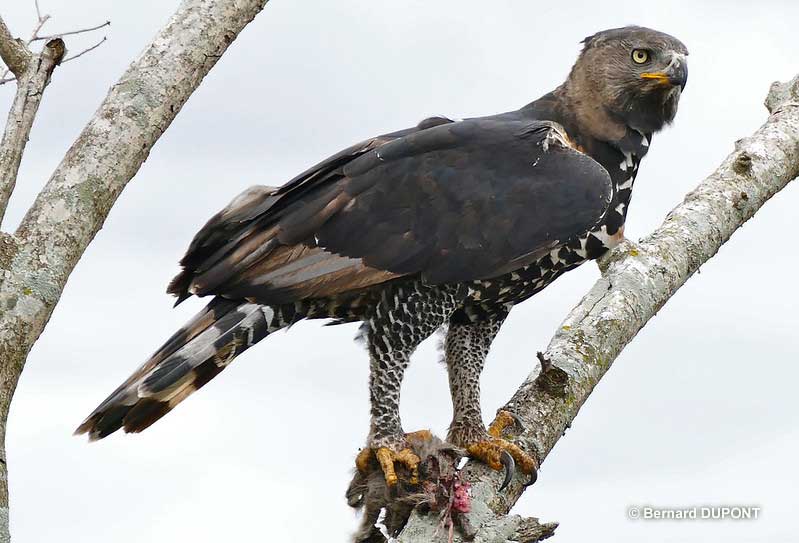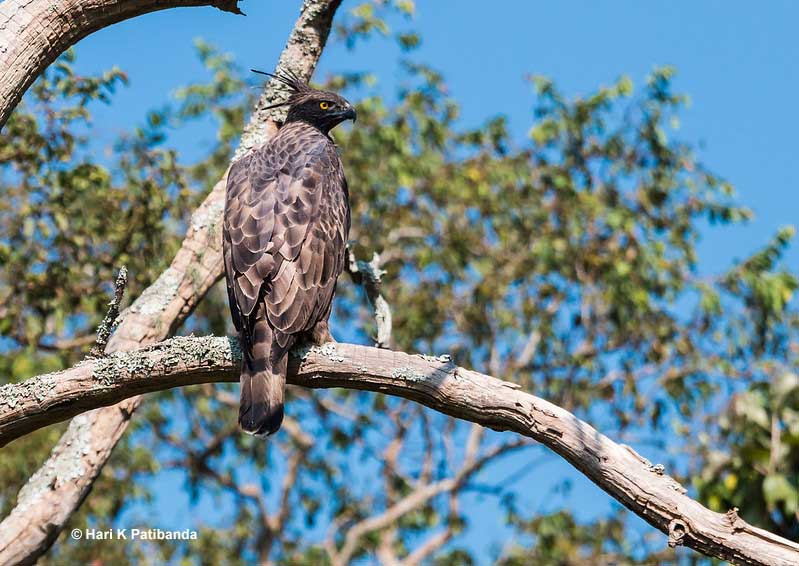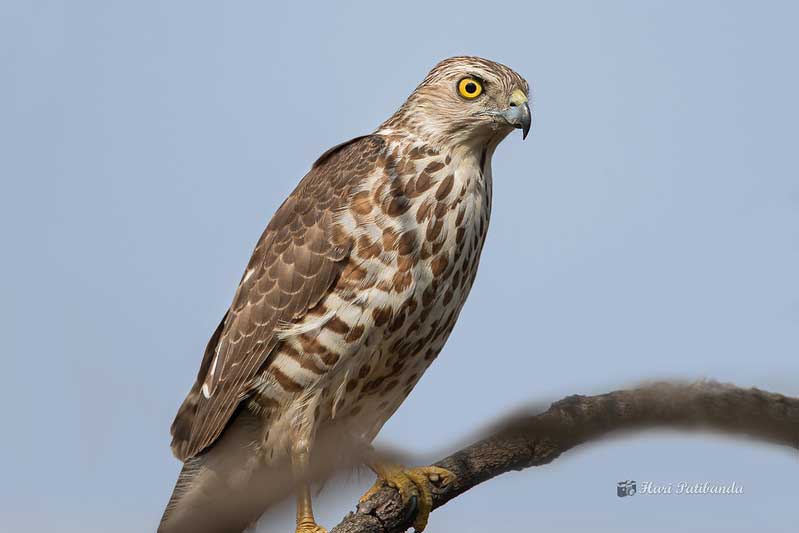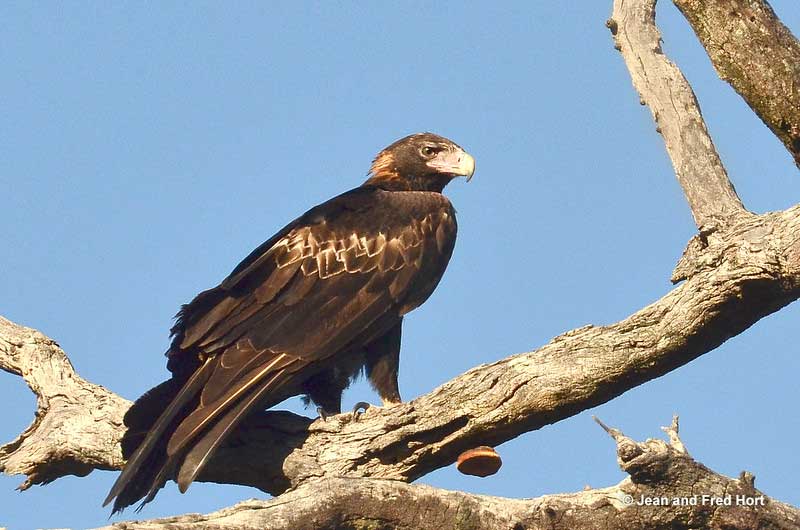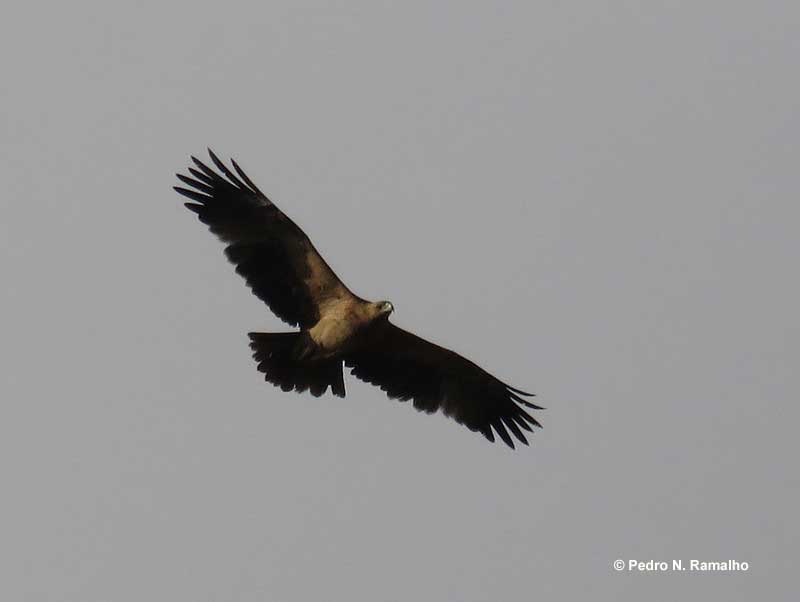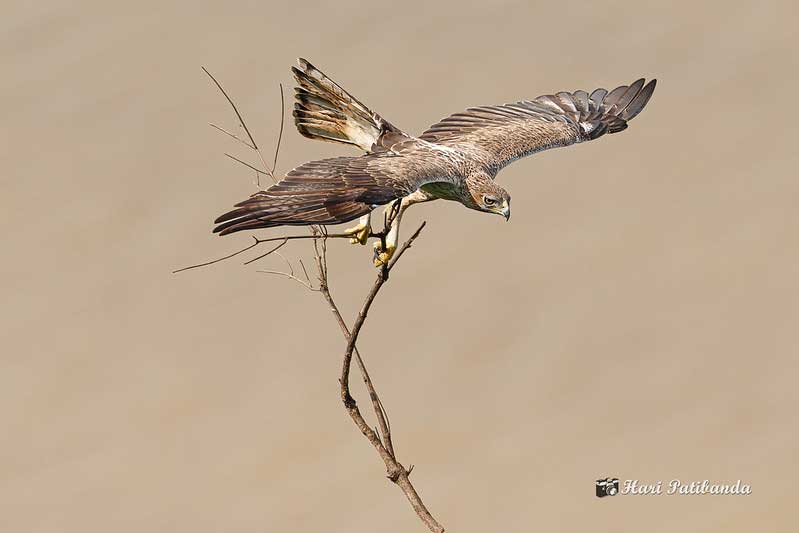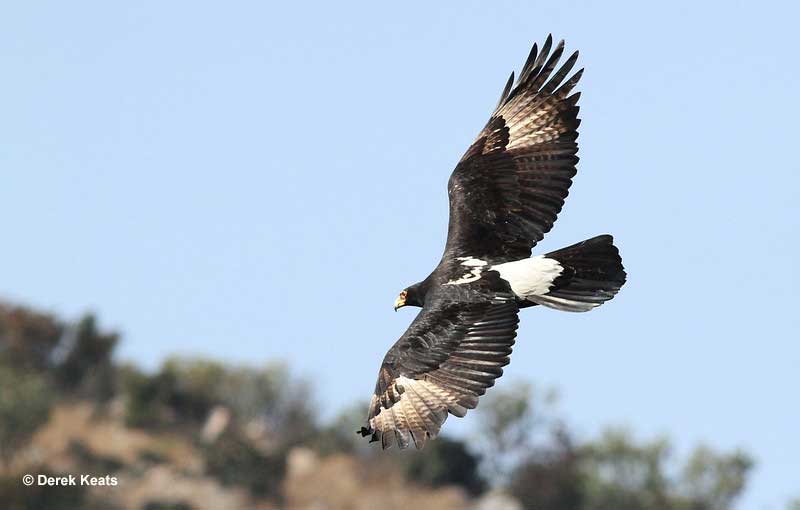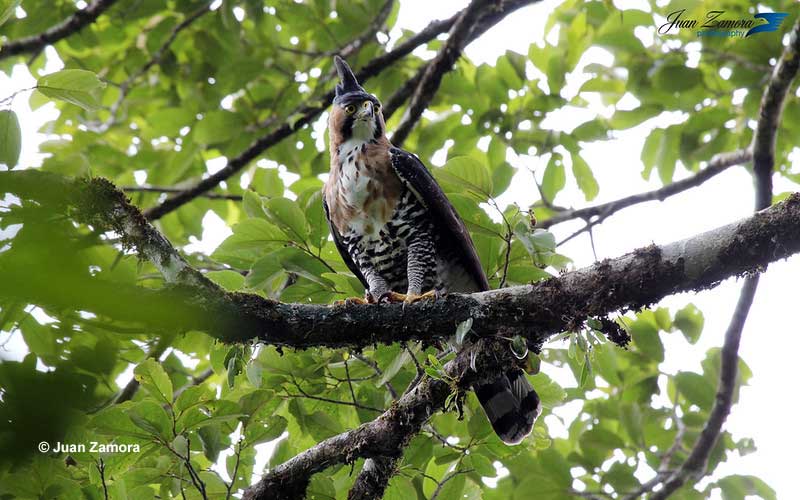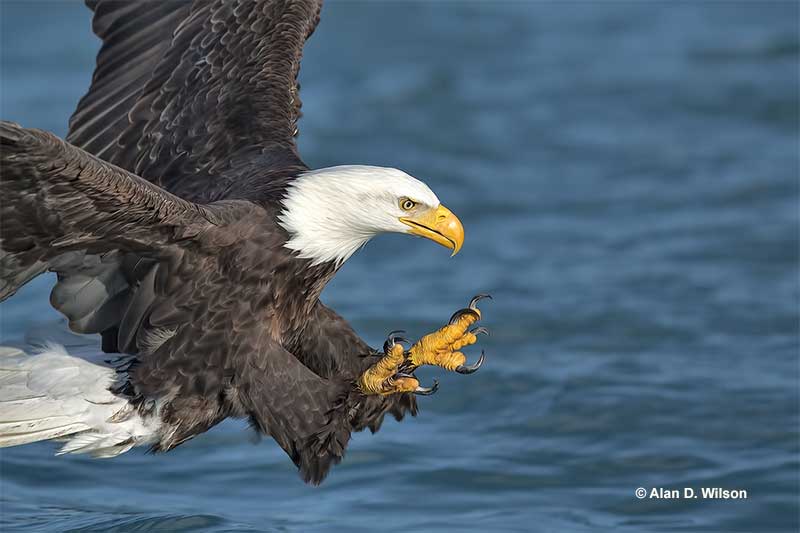
Eagles are the definition of avian magnificence. Huge and powerful raptors with sharp talons, these masters of the air always make a big impression!
However, there are so many different types of eagles around the world. They have inspired people for thousands of years and continue to be popular birds. It’s no surprise that we see eagles on flags, national symbols, team mascots, and in other places!
Which eagles live in the USA? Are they common? How many other eagles are there, and how can we tell them from hawks?
On this page
Types of Eagles
Eagles are members of the Accipitridae; an avian family that also includes hawks and kites. Although eagles are related to hawks, they differ from them in several ways.
Most of all, eagles are bigger, more powerful birds. They are adapted to catching larger types of prey and most sit at the top of their local avian food chain. Many eagles also have feathered legs tipped with powerful talons.
Some eagles are more closely related to each other than others but all are still members of the same avian family and top predators in the places where they occur.
In the USA, four species of eagles have occurred. Two of those, the Bald and Golden Eagles, are fairly common resident species. Two others, the White-tailed and Steller’s Sea-Eagles are very rare visitors from Eurasia.
In other parts of the world, we also find several other eagle species. In this article, you’ll learn about 20 of these fantastic and impressive raptors!
Bald Eagle

Scientific name: Haliaeetus leucocephalus
Size: 31 inches
Wingspan: 6.6 feet
Adult Bald Eagles are dark brown with unmistakable bright white heads and tails.
Young birds can be trickier to identify but have some white in their wings, body, and tail. All Bald Eagles also have large beaks and resemble a “flying plank” as they soar on their broad, flat wings.
Bald Eagles prey on fish, ducks, and other small and medium-sized animals. They fly down to the water to snatch fish from the surface but also eat dead fish and other carrion too. They won’t hesitate to steal fish from Ospreys and gulls either, and routinely catch waterbirds (even geese!) in the winter months.
Bald Eagles occur as pairs but several can gather at good feeding sites, especially in fall and winter. Formerly endangered, thanks to conservation efforts, we find this magnificent bird of prey around lakes, rivers, marshes, and other wetlands in Alaska, Canada, and much of the lower 48 states.
Golden Eagle
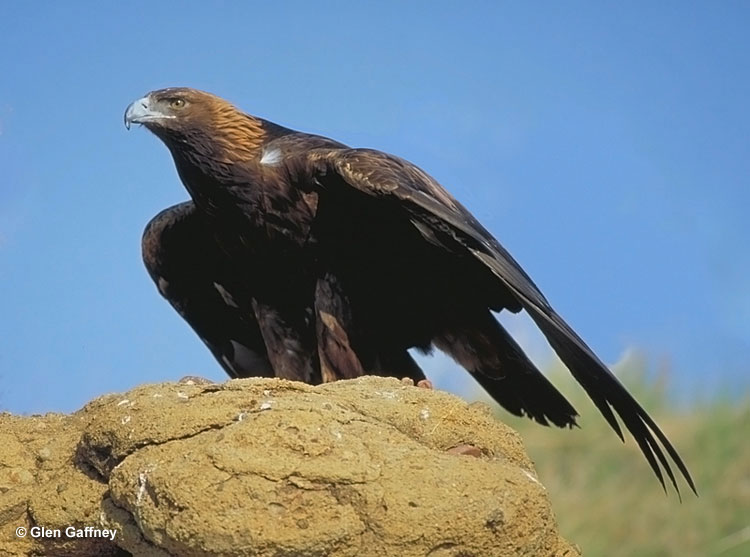
Scientific name: Aquila chrysaetos
Size: 30 inches
Wingspan: 6.5 feet
Golden Eagles are impressive, dark brown birds with paler, golden brown on their head and neck. Adults also have some pale golden-brown on their wings and undertail.
Young Golden Eagles resemble adults but have a white patch on each wing and on the base of their tail. In flight, all Golden eagles soar with their wings held in a very shallow “V”.
Related: How similar are Bald Eagles and Golden Eagles?
Golden Eagles prey on a wide variety of animals including rabbits, pikas, foxes, grouse, crows, and other birds. They also occasionally catch larger animals like cranes and young sheep!
These big birds occur as pairs and rarely flock with other Golden Eagles. They hunt in a variety of wild, northern habitats including forests, tundra, and wide, open habitats. The Golden Eagle is also the eagle species with the biggest distribution.
They live in Alaska, Canada, the western USA, parts of northern Africa, and much of Eurasia. Small numbers also winter in the eastern states.
Steller’s Sea Eagle
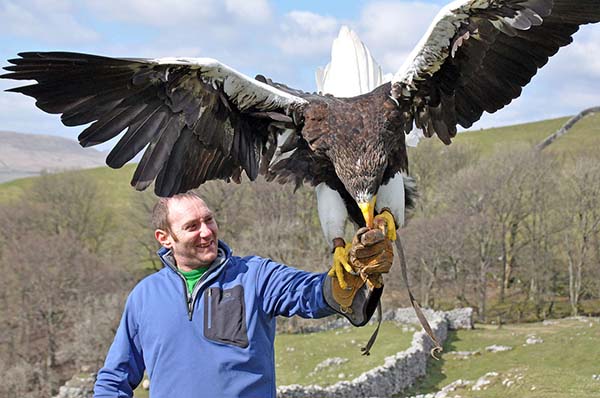
Scientific name: Haliaeetus pelagicus
Size: 37 inches
Wingspan: 7 feet
The Steller’s Sea-Eagle has the distinction of being one the biggest eagle in the world! The Philippine Eagle is just a tiny bit larger in size, but this one comes close. Weight-wise, they are the heaviest eagles in the world.
Steller’s Sea-Eagles are huge, dark eagles with massive yellow beaks, and white shoulders, legs, and tail. Young birds don’t have as much white but still have an over-sized bill, and a wedge-shaped tail.
These big raptors mostly eat salmon and other fish as well as carrion. They can also catch foxes, some other mammals, and birds but need big concentrations of fish for survival. The Steller’s Sea-Eagle is a threatened species that lives on coasts and waterways in eastern Russia.
They also winter in Japan, and parts of China and the Korean Peninsula. Birders typically see Steller’s Sea-Eagles in Japan but many lucky birders also got to see one that had wandered to eastern Canada and Maine!
White-tailed Eagle
Scientific name: Haliaeetus albicilla
Size: 31 inches
Wingspan: 6.6 feet
The White-tailed Eagle is the Eurasian equivalent of the Bald Eagle. Like its North American counterpart, the White-tailed Eagle frequents coastal habitats and waterways, and also preys on fish, aquatic birds, carrion, and some other animals.
White-tailed Eagles also have a white tail although it’s more wedge-shaped than the Bald Eagle. Overall, they are dark brown birds with paler feathers on their head, chest, and back, and a big yellow beak.
Young birds are dark brown with bits of white on their wings, body, and tail.
Rarely, a White-tailed Eagle shows up in Alaska or even in the lower 48 states. However, these impressive birds mostly occur along waterways, and in wild areas in parts of northern and eastern Europe, and Russia east to Japan.
Some White-tailed Eagles also live in Greenland and Iceland, and many winter in parts of Europe, central Asia, eastern China, and Japan.
Pallas’s Fish Eagle
Scientific name: Haliaeetus leucoryphus
Size: 31 inches
Wingspan: 6.5 feet
The Pallas’s Fish-Eagle is a central Asian representative of the Bald and White-tailed Eagles. This big bird frequents marshes, lakes, rivers, and other wetland habitats in wide open and arid habitats in China, India, Bangladesh, and some other places.
It has become very rare in Kazakhstan, Mongolia, and some other parts of its range.
While northern birds migrate to parts of southern Asia, there is also a resident population in Nepal, India, and adjacent nations.
Pallas’s Fish-Eagles are brown with pale colors on their heads and chest. They also have a black and white tail. Young birds are dark brown with some pale feathering, have a dark wedge-shaped tail, and a pale rectangular patch in each wing.
Like its relatives, this eagle preys on fish, some carrion, waterbirds, and some other animals. Sadly, wetland degradation and destruction, and deforestation in various parts of its range have caused this special bird to become endangered.
African Fish-Eagle
Scientific name: Icthyophaga vocifer
Size: 27 inches
Wingspan: 6.3 feet
The African Fish-Eagle is a striking, chocolate-brown raptor with black wings, a short white tail, and a white head, chest, and back. Young birds resemble adults but have some dark feathering on their head and chest.
This beautiful raptor is a common and vocal species along waterways in many parts of sub-Saharan Africa. They live near lakes, rivers, marshes, and other wetlands including some coastal habitats.
African Fish-Eagles mostly feed on fish but can also eat carrion, and hunt waterbirds and other small animals. They forage by waiting on a perch and then swooping down to snatch a fish near the surface. If the fish is too big, the eagles use their wings to “row” their way to shore!
African Fish-Eagles usually occur in pairs but can also gather in sizeable flocks where drying waterways concentrate large numbers of stranded fish.
This beautiful bird is common and easy to see in much of its range!
White-bellied Sea-Eagle
Scientific name: Icthyophaga leucogaster
Size: 31 inches
Wingspan: 6.5 feet
The White-bellied Sea-Eagle is a distinctive raptor of coastal habitats in India, southeastern Asia, and Australasia. Adults are white with a gray back, black flight feathers, and a short, wedge-shaped tail.
Young birds resemble adults but have some brown feathering on their head, underparts, and underwings. They also have a pale rectangular patch on each wing.
White-bellied Sea-Eagles catch fish but they also prey on a variety of other animals. They often catch waterbirds like cormorants and gulls, fruit bats, and reptiles, and also feed on carrion. This bird isn’t shy about stealing fish and other food from Ospreys and other birds, even from other White-bellied Fish-Eagles.
This striking raptor is common and easy to see in many parts of its range. In Australia, they can also occur on forested rivers quite a ways from the coast. Like most eagles, this species makes big stick nests in large trees and other suitable platforms.
Philippine Eagle
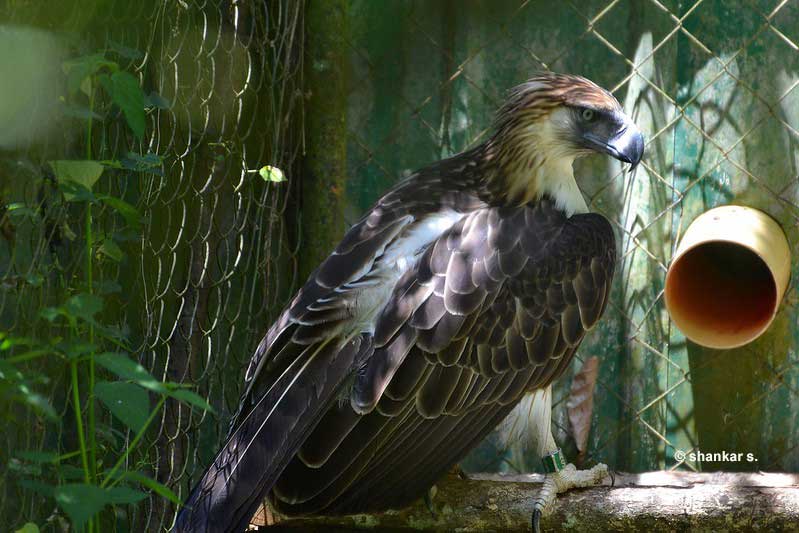
Scientific name: Pithecophaga jefferyi
Size: 37 inches
Wingspan: 6.3 feet
The Philippine Eagle is considered to be the biggest eagle in the world. Weight-wise, it is beaten by Steller’s Sea Eagles and Harpy Eagles, but according to standard measures, they are truly the largest eagles in the world. The unmistakable Philippine Eagle has a shaggy, pale brown crest, dark area around its eyes, and is brown above and white below.
It also has a plain, longish tail, broad, rounded wings, and big, strong talons.
The Philippine Eagle has also been known as the Philippine Monkey-eating Eagle. Although they do occasionally eat monkeys, as it turns out, these big raptors prey more on flying lemurs and palm civets. They also catch hornbills, hawks, and other birds as well as monitors and other animals.
Philippine Eagles can soar over their rainforest habitat, but they usually hunt by watching from a perch on top of a hill and then switching to other perches as they move downhill.
Philippine Eagles are the national bird of Philippines and are a critically endangered species that only occurs in a few remaining areas of rainforest.
Harpy Eagle
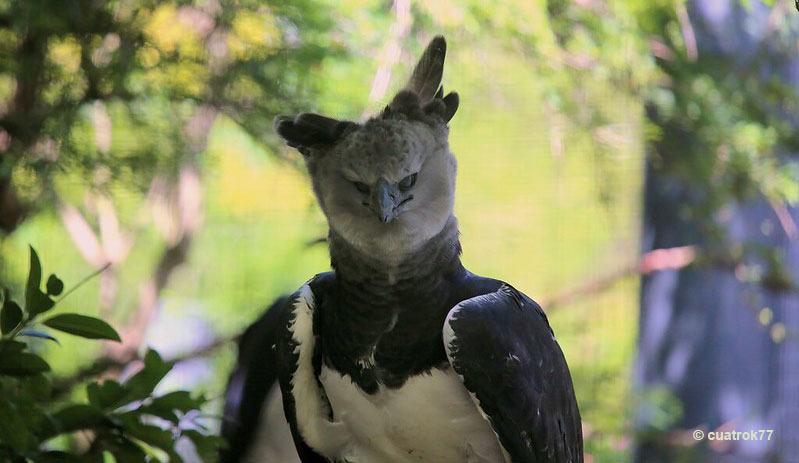
Scientific name: Harpia harpyja
Size: 38.1 inches
Wingspan: 6.5 feet
The Harpy Eagle is one of the biggest and most powerful eagles in the world. Although a couple other species are as large or larger, Harpy Eagles tend to be heavier and have huge, oversized talons.
Adults have a gray head and upperparts, a double crest, and are white below with a black chest and underwings. Young birds are much paler and lack the black chest.
This top predator hunts sloths, monkeys, small deer, coatis, macaws, and other animals in rainforests from southern Mexico to northern Argentina. It hunts prey by moving through the canopy and catching animals by surprise.
Despite their large size, Harpy Eagles aren’t easy birds to see. Unlike many eagles, instead of soaring, they prefer to stay hidden inside the forest.
Sadly, the Harpy Eagle has disappeared from many areas because of deforestation and shooting. Most birders see this magnificent raptor at nest sites in Panama, Ecuador, and Brazil.
Crowned Eagle
Scientific name: Stephanoaetus coronatus
Size: 35.4 inches
Wingspan: 5.8 feet
The Crowned Eagle is a bit like the African equivalent of the Harpy and Philippine Eagles. Like those big birds, the Crowned Eagle is a huge and powerful raptor that hunts prey inside evergreen, tropical forests.
Related: The most vibrant tropical birds
Adults have dark upperparts with a brown head and neck, and black marks and barring on their underparts. They also have a longish gray tail with a few black bands, and some black banding on their flight feathers.
Young birds look like paler adults with whitish heads and underparts.
Crowned Eagles are top predators that hunt monkeys, small antelopes, francolins, pangolins, and various other medium-sized animals. They catch prey by dropping down onto animals or catching them in flight, and pairs can also hunt together.
This impressive eagle is fairly common in many parts of sub-Saharan Africa. They live in a variety of forest and woodland habitats including some tree plantations and riparian woodlands.
Martial Eagle
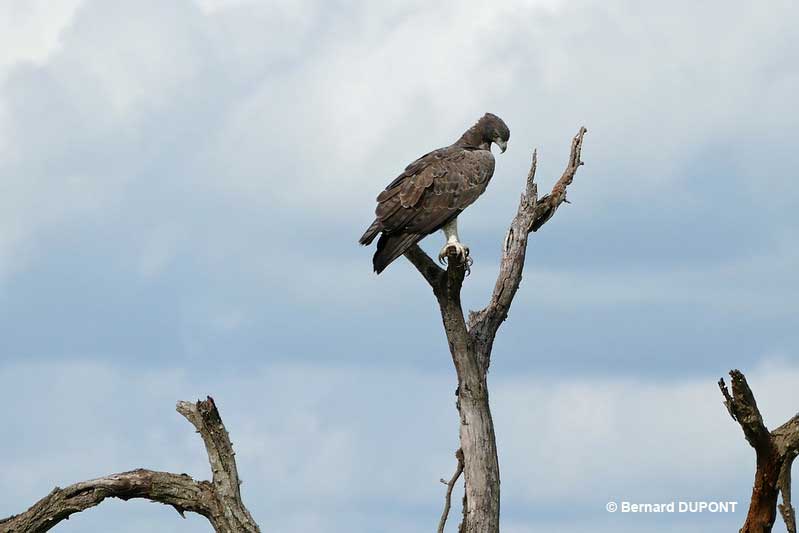
Scientific name: Polemaetus bellicosus
Size: 33.4 inches
Wingspan: 6.5 feet
The Martial Eagle is another huge eagle with some individuals being the biggest eagles in Africa. Adults are black above with a black head and chest, and have some black speckling on white underparts.
They also have long white legs, some white on their throats, a short crest, and a fairly short, broad tail. Young Martial Eagles have more white on their heads and are whiter below, including on their wing linings.
Martial Eagles hunt guineafowl, waterfowl, other birds, smaller raptors, and Ostrich chicks. They also catch a variety of medium-sized mammals including monkeys and small antelopes.
This big eagle usually hunts by watching from a perch and then flying low over the ground, directly at its prey. Martial Eagles have a large range that includes open savannah habitats in many parts of sub-Saharan Africa. Sadly, this endangered species is threatened by hunting, habitat loss that also reduces animals it preys on, and several other factors.
Mountain Hawk-Eagle
Scientific name: Nisaetus nipalensis
Size: 30 inches
Wingspan: 5.4 feet
The Mountain Hawk-Eagle is a powerful, goshawk-like eagle with a crest and longish, gray tail with a few black bands. They also have long, rounded wings with black barring on their flight feathers, and a short black line on the center of their pale throat.
Adults are dark brown above and can have pale or barred underparts. Young birds have pale or uniform buffy underparts.
These powerful eagles live in montane, densely forested habitats where they hunt a wide variety of animals. They usually wait on a perch and then swoop down to catch birds like pheasants, jays, chickens, and other medium-sized species.
This hawk-eagle also catches some reptiles and a variety of medium-sized mammals including rabbits and even small monkeys!
Mountain Hawk-Eagles live in forested parts of the Himalayas, southeastern Asia, Taiwan, eastern China, and Japan. Although they aren’t endangered, this raptor is likely affected by deforestation in many parts of its range.
Little Eagle
Scientific name: Hieraaetus morphnoides
Size: 19 inches
Wingspan: 4 feet
The Little Eagle is one of the smallest eagle species. True to its name, this bird is around the same size as our Red-tailed Hawk. Although that’s still a fair-sized bird, compared to other eagle species, it’s pretty small!
Even so, the Little Eagle is still a powerful raptor that can catch birds as big as crows and ducks, various reptiles, and mammals as large as rabbits. It usually hunts by soaring high overhead and then dropping down onto its prey.
Little Eagles can be dark brown with dark flight feathers, or brown above and pale below with dark flight feathers and a pale rectangular patch on each wing. They also have a longish, rectangular tail.
This species lives in a variety of forest and open habitats and only occurs in Australia. Within its range, although it can be easily overlooked, the Little Eagle is a common bird.
Wedge-tailed Eagle
Scientific name: Aquila audax
Size: 32.2 inches
Wingspan: 6.5 feet
The Australasian Wedge-tailed Eagle is one of the largest eagles in the world. Although their average size is smaller than the biggest eagles, the largest Wedge-tailed Eagle recorded was more than three feet long and had a nine foot wingspan!
Wedge-tailed Eagles are big, dark brown eagles with a long, wedge-shaped tail, and a huge beak. Adults also have some pale brown on the back of their neck and on their wings. Young birds have some white feathering on their body, wings, and the base of their tail.
This species has long, broad wings that help it cover long distances on the open plains of Australia. Although they can occur in a variety of habitats, Wedge-tailed Eagles usually avoid urban areas and dense forest.
They can eat carrion but also hunt a wide variety of animals including monitor lizards, various birds including cockatoos and even cranes, and mammals as large as a kangaroo!
Spanish Eagle
Scientific name: Aquila adalberti
Size: 30 inches
Wingspan: 6.5 feet
The Spanish Eagle is a striking, dark brown eagle with white on its shoulders, and pale golden on the back of its head and nape. This beautiful eagle also has long, broad wings, a rectangular tail, and a large beak.
Young birds are buffy with mostly dark flight feathers and a dark tail, or they can be dark brown with some white feathers on their body.
This species hunts rabbits, some reptiles, and a variety of medium to large birds. It can catch them by swooping down from a perch or from high soaring flight.
Spanish Eagles live in Mediterranean woodlands and other, more open habitats in central and southern Spain, and in parts of eastern Portugal.
During the 20th century, this special bird nearly went extinct from poisoning, flying into power lines, and a huge reduction in the rabbits it preys on! Thankfully, local conservationists worked hard to make changes that saved this magnificent bird.
Bonelli’s Eagle
Scientific name: Aquila fasciata
Size: 27 inches
Wingspan: 5.2 feet
The Bonelli’s Eagle is a fair-sized raptor that lives in rocky, sunny habitats with brushy vegetation. Adults are pale, gray-brown above with a pale patch on their back, and have fine streaking on their pale underparts.
They also have dark marks on their thighs, a thick, black line on the underside of their wings, and a dark tip on their longish, rectangular tail.
Young birds have a buffy brown head, underparts, and wing linings. This species hunts rabbits, partridges, reptiles, and various other animals in its rocky habitat. It can also catch fair-sized birds, even hawks, and herons. Incredibly, this powerful species has also been recorded catching and killing migrating Golden Eagles!
These agile eagles catch prey on the ground and in flight.
Bonelli’s Eagles are uncommon birds that usually nest on cliffs. They occur in parts of southern Europe, the Middle East, North Africa, India, and some other areas in eastern and southern Asia.
Verreaux’s Eagle
Scientific name: Aquila verreauxii
Size: 35 inches
Wingspan: 6.7 feet
The Verreaux’s Eagle is a large, striking eagle with a big beak, long, broad wings, and a fairly long, black tail. Adults are black with two white marks on their back, and a large white patch on their rump and lower back.
They also have white on the base of their primaries. Young birds look like adults but have brown on their back, and pale markings on their head and upper wings.
This big eagle preys on various medium-sized mammals, reptiles, and birds including guineafowl, pigeons, rabbits, crows, mongooses, and small antelopes. However, its most important prey is the Hyrax.
Verreaux’s Eagles usually catch these small mammals and other prey by swooping in and taking them by surprise. Pairs also hunt together, with one distracting the prey while the other sneaks in to catch it.
This big eagle lives in arid rocky areas in parts of the Middle East and eastern and southern Africa.
Black Eagle
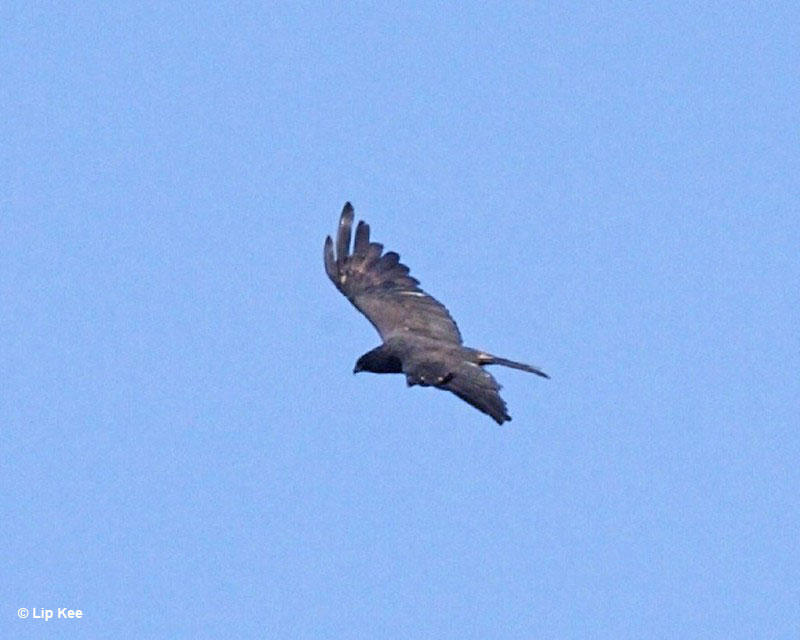
Scientific name: Ictinaetus malaiensis
Size: 30 inches
Wingspan: 5 feet
The Black Eagle is a unique raptor with long, broad wings, especially near their tips, and a long rectangular tail.
Adults are black with pale barring on their tail, and some pale coloration on the base of their primaries. Young birds are like adults but have paler bellies and underwings.
Black Eagles forage for prey by soaring and gliding just above treetops and over grassy slopes. They catch squirrels, frogs, birds, bird nestlings, and other small animals by gliding in and reaching down to snatch them from the treetops. Sometimes, they also grab and take squirrel nests right from trees.
This species lives in hilly and mountainous areas with tropical forests and woodlands. They occur in parts of the Himalayas, India, southeastern Asia, China, Malaysia, and Indonesia.
Black Eagles are uncommon but not endangered. However, they are probably affected by deforestation in various parts of their range.
Black-and-white Hawk-Eagle
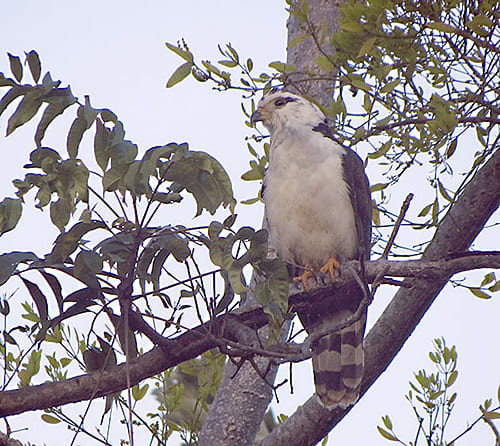
Scientific name: Spizaetus melanoleucus
Size: 22 inches
Wingspan: 4 feet
The Black-and-white Hawk-Eagle is a smallish yet powerful eagle that hunts over tropical forests from Mexico to northern Argentina. In much of its range, this raptor is a naturally uncommon or rare species.
Black-and-white Hawk-Eagles have striking white plumage with dark brown on their back and upper wings. They also have a small black mask, orange on the base of their hooked beak, and a few dark bars on their longish tail.
This species can catch some reptiles and mammals but it mostly hunts for medium-sized and fairly large birds. It often flies high overhead and then swoops down to catch its prey by surprise. They catch birds like parrots and pigeons, but can also take prey as large as guans, small egrets, and ibises!
The Black-and-white Hawk-Eagle isn’t endangered but requires large areas of intact forest with healthy populations of pigeons, other medium and large birds, and other animals.
Ornate Hawk-Eagle
Scientific name: Spizaetus ornatus
Size: 25 inches
Wingspan: 4 feet
The Ornate Hawk-Eagle is a spectacular forest eagle with a pointed crest, and orange-brown head with a black cap, black moustache mark, and white throat. It also has dark brown upperparts, white upper chest, and thick black barring on its underparts.
Young birds have a mostly white head and underparts with some black barring on their sides and legs. All ages have some speckling on the pale underside of their broad, rounded wings, and some dark bands on their long, rectangular tails.
Ornate Hawk-Eagles are powerful raptors that prey on a variety of birds, mammals, and reptiles. They can catch opossums, small monkeys, fairly large snakes and lizards, toucans, parrots, guans (turkey-like birds), and many other birds, even macaws!
This striking bird lives in rainforest and cloud forest habitats from Mexico to northern Argentina. Although Ornate Hawk-Eagles are uncommon in much of its range, they might be easier to see in Costa Rica.
Frequently Asked Questions
Are eagles and hawks closely related?
Yes, eagles and hawks are closely related. They are in the same family of birds, the Accipitridae.
Which eagle is the largest?
The largest eagle is the Steller’s Sea-Eagle. This huge raptor can have an 8 foot wingspan and weigh 20 pounds!
How many eagle species does South America have?
South America has 8 eagle species.
What kind of eagles are in Europe?
Several kinds of eagles are in Europe, including the White-tailed Eagle, Golden Eagle, Spanish Eagle, Bonelli’s Eagle, Booted Eagle, Imperial Eagle, and two species of Spotted Eagles.
Are Ospreys eagles?
No, Ospreys are not eagles. Although they are sometimes called “fish eagles,” Ospreys are in a separate bird family, the Pandionidae.
What do eagles eat?
Eagles eat a wide variety of animals, and some also eat carrion. Depending on their size, eagles eat rodents, rabbits, mammals as large as monkeys and small deer, foxes, snakes, and birds as large as geese and cranes.


